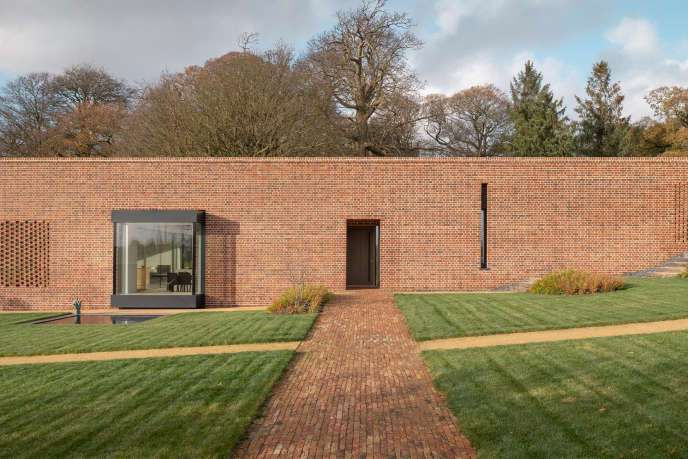
Devon Passivhaus
Passivhaus brings life to a walled garden
Planning for this project was won under Paragraph 79, the Country House Clause, with a design taking inspiration from the surroundings.
We are housemakers creating distinct, beautifully crafted, architecture in the town, the countryside, in the UK and overseas. We love what we do; delighting in the detail, the use of light and materials, the sensory, the tactile, and the making of spaces that age with grace.
We are driven by working together and with you. For us, the process is a dialogue. We listen, earn trust, foster friendships. We ourselves are a family, and are mindful that creating a home is a journey, a life experience. We are always careful to understand the way you live and what you enjoy. This is the key to designing a home that is truly yours.
As architects, we are rigorous and determined throughout every stage of the project. We have vast experience, a proven track record, and our award-winning architecture speaks for itself. Each of our buildings has a sense of belonging. Each one is a place to call home.
McLean Quinlan is a family practice. Mother and daughter duo Fiona and Kate run the practice alongside son in law Alastair across two architectural studios in London and Winchester. A handful of active projects are carefully attended to by a tight-knit team of architects and designers, all with a unique role to play.

Passivhaus brings life to a walled garden
Planning for this project was won under Paragraph 79, the Country House Clause, with a design taking inspiration from the surroundings.
The overall design is simple and clean. An elegant brick from complements the brickwork of the old garden Walland a discrete front door opening references the gate in the garden wall. Further down, an oriel window breaks through, hinting at what is behind. Elsewhere, external surfaces are dark render, designed recede visually in deference to the surrounding garden.
Tucked within, the house has a glass roofed courtyard at its centre, a winter garden flooding light into the interior. Spaces are arranged around this central core so the building functions both as a home and a gallery for our clients, great collectors of pottery and art, with spaces to display and curate.
Comfortable and serene interior spaces are punctuated with tactile and textured materials: reclaimed terracotta, rough sawn oak and clay plaster, to ensure that internally the building feels connected to the garden that inspired it.
Quiet courtyard in the heart of the city
A London home nestles neatly between two rows of terraces on a tight urban site within a historic conservation area.
The old house required demolition in its entirety leaving just the party walls either side. The stucco façade was then faithfully rebuilt and enhanced in harmony with the street with the addition of a new porch.
The site is a long narrow slot which becomes larger towards the middle of the plan. The proposal was to create a modern, light and efficient home, highly crafted, with an external courtyard at its centre.
To minimise the transition between inside and out, the living space connects directly to the courtyard with internal walls running flush with external walls.
Glimpses of planting accents and reflections are visible throughout, drawing you into the house and heightening a sense of connection with the outside.
The home is simultaneously both open and private despite the close proximity of 12 neighbouring properties.
Internal spaces hinge around an oak staircase with circular skylight above where natural light floods the depth of the plan.
A crafted modernist home overlooking the Chilterns
Our client always wanted to build a light-filled, modern home, using natural, timeless materials that seamlessly link indoor and outdoor spaces.
The house sits high, overlooking gardens and rolling countryside. The approach is via a causeway of granite slabs across a shallow pool, flanked by a ‘floating’ dining pavilion. A dry stone wall wraps around the building at the entrance courtyard.
This home needed to be beautifully built, with a craftsman’s eye and skill. On entering, the building reveals the surrounding countryside through walls of glass and here the house separates, leading on one side to more formal areas, including studies and a guest suite and on the other to more relaxed family living spaces.
The formal limestone façade of the southern elevation references both the traditional English country house as well as classic modernist villas. The building blends into the parkland landscape. Many of the walls were designed to be covered, in time, by climbing plants. Similarly, the roofs are planted with heather and lavender.
A flint home on the waterfront
On a prominent location next to the coastal path, this contemporary handmade house is careful to respect its sensitive Area of Outstanding Natural Beauty location.
Designed as a collection of volumes, neat red brick wings are positioned to allow a finely crafted flint façade to take centre stage when viewed from the sea.
The house is positioned to face two ways: with views out across the harbour to the north and towards an informal courtyard garden to the south.
Traditional materials of flint, brick and timber are used throughout. Internally these textures mark the divide between the separate wings of the house.
Inside, the main stair to the west works in conjunction with a narrow, boat-like stair to the east. In the central space; a timber ceiling, full width high-performance glazing and raised external decks, allow the sea view to be enjoyed together with the sun.
Cabin perched high above Grand Teton National Park
Perched high above the town of Jackson with wide views of the snowcapped peaks and vast valley of the Grand Teton National Park.
Our clients, themselves exceptionally talented designers, embarked on this project after falling in love with the place and set out on a journey to create a beautiful home in this extraordinary landscape.
The design unites elements of both European chalet and classic American cabin. The orientation, design and natural materials – reclaimed and new – ensure the building links to the land.
The silvered cedar shingle roof blends with the majestic landscape beyond. As the years pass the external stonework will cover with lichen, the sagebrush will gradually creep up to the boundaries of the house as the building marries with the landscape.
The detail and feel of the house were developed in close collaboration with our clients. A restricted palette of natural materials and tactile elements were chosen to be improved by the patina of use and age to contribute to the ambience of the house.
The smell of timber, the feel of the flooring underfoot, tactile contours of handles and handrails, and the breeze that passes freely through the house when the glass walls are slid open. The experience is sensory and authentic to the place.
A clearing amongst Aspen and Pine makes way for an understated home, positioned to take in long views across Snake River Valley and the mountains beyond. Our clients wanted a house that embraced this majestic setting. A peaceful, modern retreat to recharge whilst immersed in nature.
Our clients came to us after visiting another project of ours close by. They were looking for a design to replace a dilapidated cabin on the site, designed in a traditional cabin style the home was dark and had little connection to the site it occupied and had fallen into disrepair.
Key to the new design, was to create a home which was light filled and connected to nature. The site backs onto a forest of Aspen and Pine as you arrive to the house you are met by the wide open views of the valley and mountains beyond. The home sits in the valley of the Snake River looking out towards mountain ranges and the Sleeping Indian.
The building is formed of two contrasting volumes. The first ‘living’ structure is transparent, open to panoramic views, and filled with natural light from sunrise to sunset. A substantial douglas fir frame provides a feeling of warmth and enclosure.
The second, taller, black timber-clad building contains more practical aspects of the home, including the bedrooms. Upstairs, tucked into the eaves, the library and guest rooms nestle under a tent-like vaulted roof.
A limited palette of natural materials and tactile elements were chosen to reflect the surrounding landscape. Oak flooring and hemlock ceilings, reminiscent of traditional cabins, contrast with expanses of frameless, thermally insulated glass. A contemporary home that both respects and takes advantage of its extraordinary setting.

Error: No connected account.
Please go to the Instagram Feed settings page to connect an account.
v5.0
When you register as a free Member of the Remodelista family of websites (Remodelista, Gardenista, and The Organized Home), you gain access to all current posts plus 10 archived posts per month, our internal bookmarking tool, and the community bulletin board.
Member benefits include:
For $5/month ($59.99 paid annually) you'll enjoy unlimited, ad-free access to Remodelista, Gardenista, and The Organized Home and all the benefits of Membership.
Subscriber benefits include:
For $5/month ($59.99 paid annually) you'll enjoy unlimited, ad-free access to Remodelista, Gardenista, and The Organized Home and all the benefits of Membership.
Subscriber benefits include:
Benefits include:
For $5/month ($59.99 paid annually) you'll enjoy unlimited, ad-free access to Remodelista, Gardenista, and The Organized Home and all the benefits of Membership.
Subscriber benefits include:
When you register as a free Member of the Remodelista family of websites (Remodelista, Gardenista, and The Organized Home), you gain access to all current posts plus 10 archived posts per month, our internal bookmarking tool, and the community bulletin board.
Member benefits include:
If at any time you want to become a Subscriber and enjoy unlimited, ad-free access to all our content, just go to the My Account link and choose Subscribe.
Advertising funds our work at Remodelista and helps us provide you with a daily dose of design. We hope you’ll consider disabling your adblocker for Remodelista so we can continue our mission: a well-designed home for all.
Thank you for your support.